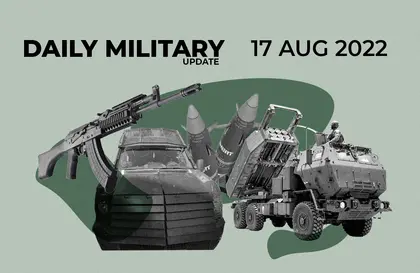Russian Federations (RF) authorities in Crimea were attempting to lock the peninsula down in the wake of a series of possible Ukrainian guerrilla strikes against a key rail transshipment center, power distribution infrastructure and a major air base, news reports and official statements stated on Wednesday, August 17.
RF occupation authorities on Tuesday, August 16 declared a “state of emergency” across Crimea and set up cordons of army troops around the locations of the Tuesday Ukrainian attacks against an arms depot near the town of Dzhankoi, a rail switching yard adjacent to the arms depot, and the Gvardeyskaya air base near the Crimean provincial capital Simferopol.
JOIN US ON TELEGRAM
Follow our coverage of the war on the @Kyivpost_official.
RF checkpoints were allowing only military traffic and personnel inside five-kilometer security zones set up around the attack sites. In the town of Dzhankoi, authorities evacuated 2-3,000 local residents from their homes, news reports said, citing Crimean officials.
Secondary explosions from ammunition burning in the vicinity of the Dzhankoi rail switching station continued overnight. Detonations were reportedly continuous but stopped mid-morning on August 17, according to news reports.
Epic traffic jams of civilians leaving Crimea via the Kerch bridge were reported by both independent Ukrainian and state-controlled RF media. Vehicle queues stretched as much as 15 kilometers as motorists passed security checks before police permitted them onto the bridge.

Poland Scrambles Jets During Russia’s Missile Attack on Ukraine
At least 38,000 cars and trucks left Crimea via the Kerch bridge on Tuesday, August 16, the UNIAN news agency reported, citing RF officials. RF state-controlled news platforms reported a peninsula-wide manhunt was in effect to find saboteurs thought to be responsible for the attacks.
Ukraine Armed Forces (UAF) units since the outset of the war had not openly attacked Crimea targets, according to most observers because the UAF lacked weapons with sufficient range, or behind-the-lines troops capable of performing serious sabotage missions.
That paradigm changed on August 9 when an RF naval air base near the town of Saky was rocked by at least six and possibly more major explosions. Subsequent satellite images showed the airfield cratered by the detonation of at least three powerful explosive devices. UAF officials later took credit for the strikes, without specifying how the attacks were carried out.
RF authorities claimed at the time of the Saky blasts, responsible for the destruction of at least seven combat aircraft and four munitions storage sites, were the fault of RF troops mishandling ammunition. The strikes against Dzhankoi and Gvardeyskaya air base, in contrast, marked the first time both RF and UAF authorities stated definitively that the UAF had carried successful major attacks in Crimea.
Sergei Aksyonov, the RF-appointed head of occupation authority in the peninsula, said security across Crimea would be tightened drastically so that the Ukrainian saboteurs might be hunted down. Aksyonov’s government placed all of Crimea under effective martial law following the August 9 attacks.
Aksyonov said two civilians had been injured in the Dzhankoi attack, but offered no details on possible damage. He likewise made no comment on possible injuries or damage at Gvardeyskaya airfield, a critical node for the RF’s national air space defense in the Black Sea sector.
The Tuesday, August 16 blasts took place in the morning hours. According to statements and images posted on Crimea-based social media, the Dzhankoi arms depot attackers set off at least two devices triggering fireballs and billowing black smoke. An electricity substation nearby was also demolished, and rail movement parallel to the depot was widely reportedly as completely halted.
According to unconfirmed reports on Telegram channels associated with the UAF military, such as StraKomVSU, at the time of the Dzhankoi explosions RF rail workers were unloading a train loaded with 17 infantry fighting vehicles, 10 self-propelled howitzers, 2 self-propelled heavy cannon, and 3 rocket artillery launchers.
According to an unconfirmed report originating with Russia’s Kommersant’ news magazine, RF authorities were investigating the possibility that kamikaze drones carried out the airfield attacks.
On paper, the UAF lacks weapons with sufficient range to reach from Ukraine-controlled territory to targets within Crimea.
Military observers have suggested that a recently-developed longer-range UAF guided missile, long flight duration drones converted by the UAF into remote-controlled strike weapons, Ukrainian army special forces, or Ukrainian partisans might have carried out the August 16 attacks.
You can also highlight the text and press Ctrl + Enter






